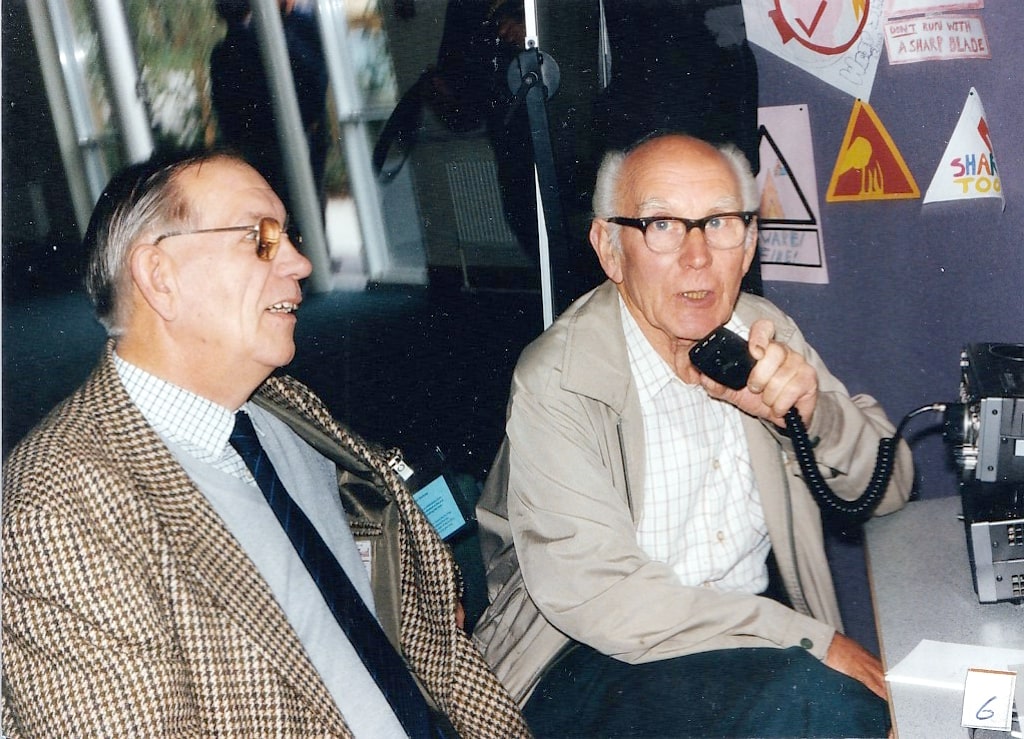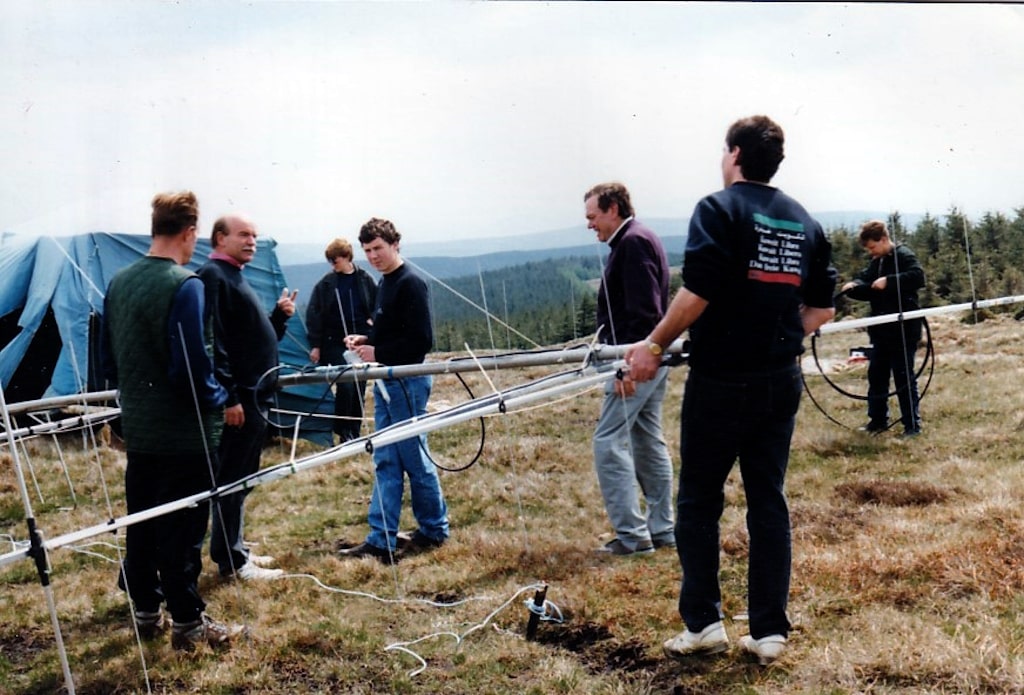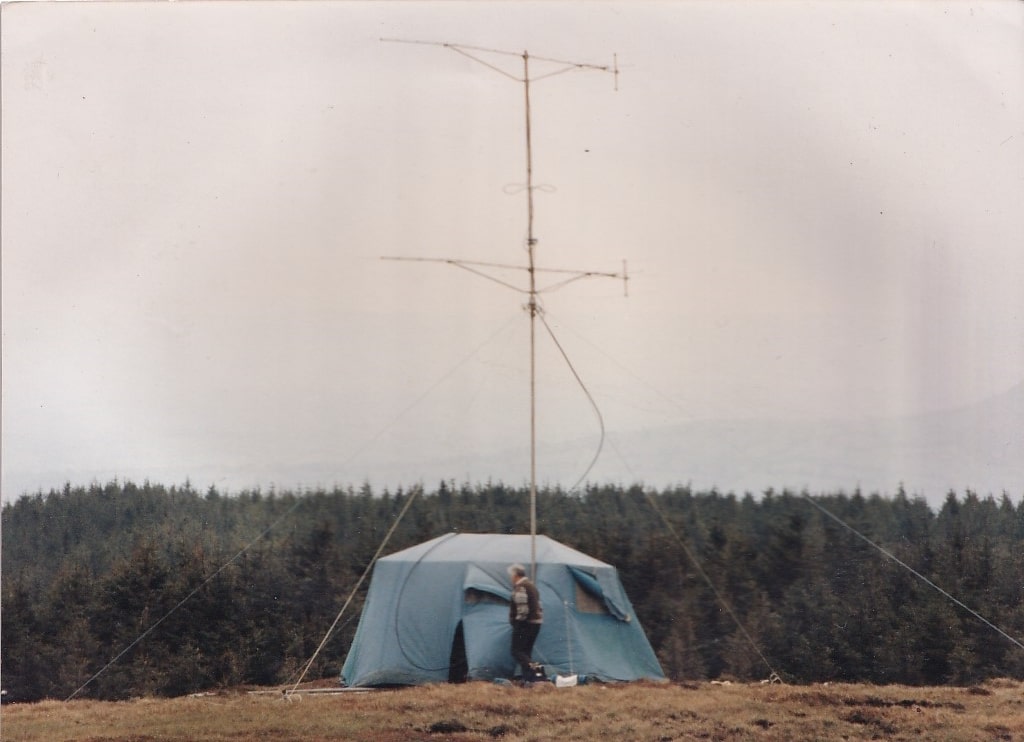
Standing L to R
Brian Croker G3ULJ (SK 31/7/1986), Charlie Watkins Jnr G8AON/G4PQT, Keith Winnard G(W)3TKH, unknown, John Haynes, Glen Ross G8MWR (SK), Reg Broadberry G1PNF (SK), Bryn Tinton G3SWC, Brian Viney G8BPG/GW4KDP, Phil Whitchurch G3SWH, unknown, John Weston G3LYW (SK), Roger Powell G3RUJ, Mike Batt G3SJI, Tom Boucher G3OLB, Dick Winkworth G3SJZ, Brian Jessop G3NOO (SK), Pete Bubb G3UWJ, Vernon Baldwin G3ULU (SK), John Leonard (G4UZ Jr), Brian Thompson, Robin Thompson G3TKF, “Uncle Len” Harold Leonard G4UZ (SK(18/12/1994)
Sitting L to R
Ted G3TWT, Charlie Watkins G3TTZ, Eddie Davis G3SXY (SK 26/2/1989), unknown, Ken Marr, Chris (YL of Ray Adamson the photographer), Anne (XYL of G3OLB)
Invitation to join BARC
Below is a letter from Len, G4UZ which was sent out to prospective members to join the club.
BARC Beginnings
This brief history of the Club’s early days covers its inception in about 1964 to 1970, and is largely a collection of personal memories – G3TTZ.
The idea of a club, as distinct from the Bristol RSGB Group occurred to Harold Leonard who held the callsign of G4UZ in the 1930s when he was a member of the Redcliffe Radio Club. Having allowed his licence to lapse during his war service in the RAF, he re-sat the examinations and obtained G4UZ as his callsign after the war, the earlier one not being available. Remembering the pre-war amateur activities, Harold thought there was room for a similar club, meeting twice a week (Tuesdays & Thursdays), to complement the Bristol RSGB Group which functioned more as a ‘learned body’, meeting monthly.
So was born the idea. A nucleus of interested people then licenced in Bristol including Len G4UZ, Mike G30UK and Joe G3TIV, formed a committee and began a search for premises. It was fortunate that at that time the Barton Hill flats were being constructed, that Joe was site foreman and he had a friendly relationship with the staff of the University Settlement (no doubt fostered by the availability of coffee there! ).
The University Settlement
Premises were composed of the main building in Ducie Road, after which several adjoining slum houses were acquired, the intention being to eventually replace them with new prefab structures. Negotiations between the Club and the Settlement were resolved with BARC being allowed to use one of these old houses which demonstrated its age and condition by the manner in which the upstairs clubroom floor rose and fell by several inches when members filled it, continually threatening to deposit them in the room below. Many were the impromptu talks, discussions, arguments and lectures enjoyed in that room, often started by one of the members asking “How does an aerial work?” or even, tongue in cheek, criticising the government of the day. Of course, these light-hearted moments of informal instruction were supplemented by serious study, and groups of members received instruction in the mysteries of the RAE and learnt CW from their dedicated seniors – the two Micks, G30UK & G3SJN figured large in these episodes and many, such as the writer, who obtained their callsigns at that time have much to thank them for.
During such episodes, the kitchen staff composed of members’ YLs (XYLs were far too canny!) prepared coffee for the benefit of all whilst the Committee which met regularly in an adjoining room organised such things as the payment of subs, a two-level arrangement where working members paid the full amount of, I think, 1/- per week and the schoolboys 6d, and organised future activities. It was not long either, for many of the likely lads to discover the ‘Swan’ just around the corner where many of the topics discussed earlier were carried on over a pint after the Club had closed.
The Club station was set up at about this time too, with a KW Vanguard TX, followed by the purchase of a Heathkit HW100, the kit being built by G30UK. Robin G3TKF tells of the time when the shack was burgled, the HW100 stolen with a note left suggesting that a stronger lock on the shack door was needed; two weeks later the shack was burgled again, the PSU taken and another note left saying “Why didn’t you strengthen that lock?”. .
At the Settlement Annual Open Night, one section would be invited to display its talents each year. BARC’s turn was probably in the autumn of 1966 or 67, when a mobile whip was mounted on the flat roof of the prefabricated building of which Miss Jones the Curator was justifiably proud, and a Top Band station installed to demonstrate the magic of Amateur Radio. G4UZ went off mobile round the city (actually round the block) and gave a 5/9 commentary of things which were happening ‘In Town Tonight’, including a vivid account of a burning building which nobody else appeared to have seen before, then, or since! This thrilling narration was hooked up to the Tannoy system in the Settlement by G30UK, to allow all present to witness the type of activity indulged in by BARC.
The Great anti-RSGB provocation & NFD
Certain members of the Bristol RSGB Group, appearing to resent the formation of what, to them, seemed to be the beginning of a rival organisation in the city, decided to take action when it was learned that BARC was considering entering an NFD station, and became sufficiently agitated to circularise many callsigns in Bristol deploring this move, likening it to “as if Bristol Rovers Supporters Club were to enter a team in the F.A Trophy competition”.
This, as one might expect, caused much wrath in BARC at that time already affiliated to RSGB, and despite Len G4UZ’s repeated protestation that “it’s only a hobby”, led to fierce anti-RSGB sentiments being expressed and a resulting commitment to enter a station at all costs. Feelings ran high over the episode and a full complement of aerial erectors, operators, log keepers, helpers, cooks, etc set up a station and took part.
The placings in that year’s NFD have not survived, but rebel Club members persisted in their attitude until a peace parley chaired by the late Reg Griffin G5UH (RSGB Region 9 Rep) and G4UZ, smoothed things over to the satisfaction of both parties, after which the Club and RSGB Group happily ran their own stations for a number of years.
G3ULJ, had by now come into the picture. Brian was a dyed-in-the-wool radio man whose war service included membership of the British Forces Network station team which provided the Services with programmes during the advance into Europe, then on return to civilian life, manning the Gas Board radio station sited at Malago in Bedminster. He was a great judge of character whose blunt manner often disguised his underlying sense of humour, and he used these attributes in acquiring the Gas board sports ground for Club use over NFD weekend (3/4 June 1967), this leading to a number of successful NFDs being held on the site in subsequent years..
We were fortunate in having a number of first class CW men available to operate the Club station, among them Tom G30LB, Phil Whitchurch G3SWH (later to use these talents in the Merchant Navy), Bryn G3SWC, Dick G3SJZ (whose callsign has now lapsed), Robin G3TKF, and Pete G3INR, all of whom have progressed in their chosen professional field, thanks to the basic interest in electronics fostered in no small way by BARC.
BARC Mobile Activities
In 1964 most /M stations operated on Top Band. TX & RX were relatively easy to build, largely from the junk box, and a homebrew DC to DC converter was required to provide the 250 volts HT necessary for the valve line-up, with 12 volts used for pairs of 6.3 volt heaters. Due to this, the lesson was soon learned that it was wise to park on a slope when operating static in order to obtain a rolling start with the ensuing flat battery. Antennae were mostly home brewed and a fine collection of heterogeneous designs were visible at rallies, most being forms of base loaded whip.
G30UK and Bill G2HFG were among the first Club members to sport M/ rigs. Bill used a helically wound bumper-mounted fishing rod whip which impressed us less experienced members and encouraged us to great efforts. G4UZ could be heard at 8am every working day enroute to work; since his was a company car and could not be modified, it was necessary for him to slip the loading coil section over the existing whip and to use the normal car radio with a homebrew converter » then switching to the homemade transmitter when required.
Of course, having built the gear, one was not allowed to use it in motion without a special /M licence, so until the necessary piece of paper came through, one drove to a spot, stopped the engine and operated /P.
BARC members seemed to favour three basic forms of mobile activity. Our own RSGB Group’s Longleat Rally sparked the interest in attending others, which in turn led to small groups from the Club converging on country watering holes at any given moment, such functions being beloved of the late Eddie G3SXY, who coined the phrase ‘Instant Rally’ to describe them. Lastly, there were Club weekends, when some of the mobile trips made in 1966 were to rallies at Hurn Airport, Upton on Severn, Swindon, Derby, and to the RSGB Exhibition. London, where it was fun leading a number of mobiles up through Oxford Street on a busy Saturday afternoon and ensuring we all stayed nose to tail!
Best remembered was the camping weekend at the Gower Coast, starting on 1st July 1967 Mike G30UK was the moving spirit in this venture and the trip was made by a hard core of /M Club stations, including Tom G30LB, G30UK, G4UZ, G3SXY, G3TKF, G3TLS , G3TTZ, G3ULJ and G3WLZ, all with their families and also a number of other Club callsigns with receive mode only in their vehicles. Such was the Club spirit prevailing the mobileers were seen off from Bristol and welcomed back home, by other members such as Eustace G3RAJ, Mick G3SJN, Ted G3TWT, Alan G3UGB, Percy G3VVI, and Bob G3WEV. Enroute we ran into a traffic jam approaching Swansea and were walked round the back streets with no delay, still in nose to tale formation by an obliging local, GW3MOP.
Other Club Activities
Sunday mornings saw much on-the-air activity, usually starting with the gentle voice of G4UZ calling CQ and other members calling in until lunch time; sometimes most of the net would migrate to 28Mhz during this, the sunspot minimum. Slow morse was also transmitted. On one occasion the writer went out /M, leaving the station RX hooked up to the tape recorder; this record of a BARC Top Band net is still in existence.
Then there were the spate of DF hunts, again sparked by G30UK who would set up his carefully concealed station, transmit for five minutes every half hour, then cry with laughter at the antics of Club members attempting to find him, some becoming more irate the further they progressed from the transmitter instead of towards it. It is on record that G3ULJ came in last on his 43rd birthday, 30th April 1967.
Bath Amateur Radio Club was invited to take us on in a skittles contest. A properly designed challenge was prepared on handmade paper and delivered to G3LYW’s QTH; the gauntlet having being thrown down, battle was joined between the two clubs at a watering hole at Box, with the result being lost in the mists of time. Perhaps we lost.
During the winter months, Club projects were popular. These included a 2-metre converter inspired once again by G30UK, using a Nuvistor valve; it was built on a small(!) chassis (about 6″ x 6″, these being the days of such techniques for VHF). One of these is owned by G4PQT and still functions. Also remembered is the way in which G2HFG astounded the tyros with his demonstration of how to build a crystal-controlled, one valve transmitter and have it on the air all in one evening.
Characters recalled
Every group of people has its complement of characters, and BARC was no exception. David Nicholls, a schoolboy affectionately known as ‘Ginger’ (now G6AEC and a responsible husband and father) habitually monitored Top Band whilst on his paper round, using his transistor radio suitably modified by other members for the purpose, Ray and XYL Chris Adamson, both SWLs and members of the Salvation Army. “Cliff” who married the daughter of G3TLS. The local pirate who kept being caught, taken to court, fined, then buying his accuser a pint. I wonder where they all are now?
The likely lad who was prone to use a signal generator to kid gullible locals that they had landed an exotic piece of DX on 28Mhz until it became known that the “DX” emanated from a TV repair shop signal generator in Westbury-on-Trym; this was all forgiven in the hilarity of hearing the same chap using his echo chamber on Top Band and Authority unable to find that it contravened the licence regulations. but telling him to Stop It, just the same. Happy. days.
Then there was G8AON who was almost a carton design apprentice but found this way of life boring, so used his time to design illicit boxes at work for pieces of gear he was more interested in making at home, then transferred to TV servicing. They said “G8AON? that means All Or Nothing – get stuck in on the CW lad, and get your full licence.” But this rebel wasn’t interested until much, much later, when he joined the Establishment and became G4PQT!
Pete G3INR was such an expert CW man that members accused him of hiding a mole in his fist, as it did not appear to move when he was transmitting! Then there was G3PFD Ron, who almost had an hour of glory when, having read that an antenna’s resonant length shortens drastically under water, used a plastic tube containing a wire of the calculated length sealed at each end and filled with H20. He was able to load it but alas, no DX.
Bob G3WEV and Jeremy G3XEI were in this country from South Africa, and kept a regular sked on 21Mhz with home from their QTH at Whitchurch.
Between 1968 and 1971 John G3RKH, a curate at St. Mary Redcliffe Church was a member of BARC and did a spell as Hon Sec of the Club. John is now Vicar at St. Matthews, Halifax, and is still active on the bands.
Silent Keys
This last section is the saddest, containing as it does the names of those who helped to get the Club off the ground and keep it going in its early days. They included :-
- G3TIV Joe Hope, foreman during the building of the Barton Hill Flats. He had done much to find the Club’s first premises, and was tragically killed in an industrial
accident on the works site in Cornwall. - G3RAJ was a blind Methodist local preacher. On Sunday mornings Eustace took the service in and around Totterdown, and had a phenomenal memory which made him word perfect in presenting the hymns and sermon he delivered, of course, without notes. Even in his seventies he would make his way to Temple Meads Station, find the right Platform and catch the correct train to Pensford or some such village for an evening service, followed unknowingly, by a friend who ensured he did not walk off the platform edge. When at home on Sunday afternoons he was a regular on Top Band.
- Jack Hopkins (SWL), always cheerful. He would be glad to know that son Steve is now G1IHL.
- G3SXY Edwin Davis. A founder member and first Club Secretary. Eddie’s whimsical humour never left him despite a troublesome physical disability. He was always the one who would produce exactly the right component from the depths of his beloved Mini for a club member whose rig had broken down on a rally weekend.
- G3TND Colsten Toogood was a quantity surveyor who used his professional talents on behalf of the Club many times. His early interest was mainly on 2-metres in the days when those valved rigs were of ‘plumber’s delight’ construction. This was followed in later years with RTTY and SSTV.
- G3ULJ became a tower of strength in local amateur radio circles. Following a spell as Chairman of BARC Brian, with G2FYT, rescued the Bristol RSGB Group from extinction and spent the next nine years as its Secretary, during which time he also organised Longleat Rally. It was through his efforts in this rebuilding the foundations of today’s successes were relaid. The headstone on Brian’s grave in Bridgewater cemetery reads: –
“In memory of Brian John Croker G3ULJ 30 April 1924 – 31 July 1986” and this is followed with the characters ‘VA’ in morse. – - Other silent keys included G3ULU Vernon & Ken G3WIF who were members for a time.







